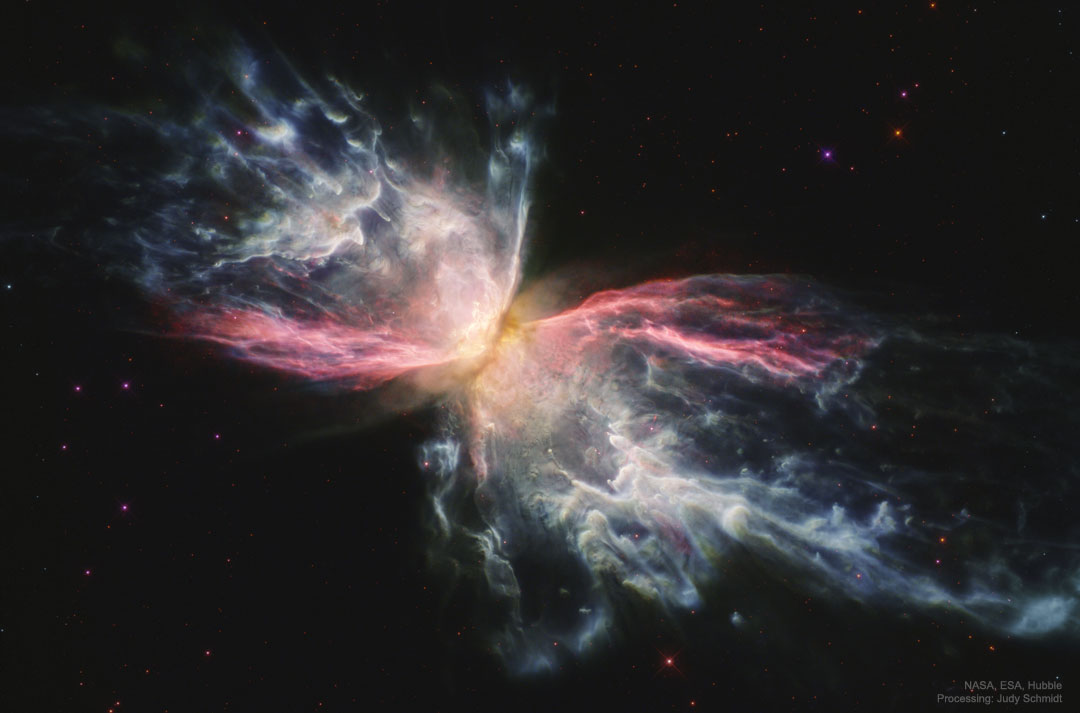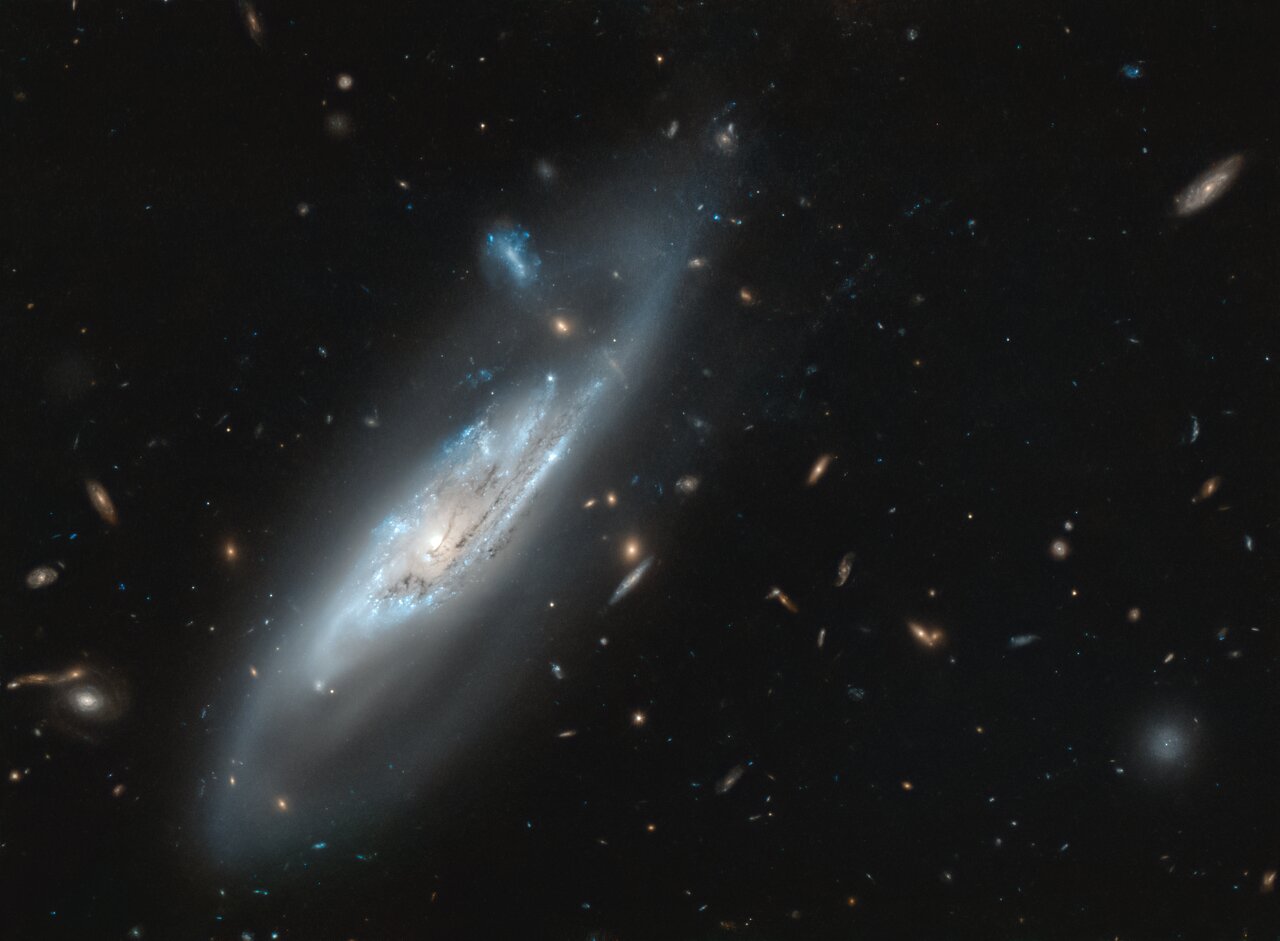Herman “Junior” Cook (July 22, 1934 – February 3, 1992) was an American hard bop tenor saxophone player.
Cook was born in Pensacola, Florida.After playing with Dizzy Gillespie in 1958, Cook gained some fame for his longtime membership in the Horace Silver Quintet (1958–1964); when Silver left the group in the hands of Blue Mitchell Cook stayed in the quintet for five more years (1964–1969). Later associations included Freddie Hubbard, Elvin Jones, George Coleman, Louis Hayes (1975–1976), Bill Hardman (1979–1989), and the McCoy Tynerbig band.
In addition to many appearances as a sideman, Junior Cook recorded as a leader for Jazzland (1961), Catalyst (1977), Muse, and SteepleChase.
He also taught at Berklee School of Music for a year during the 1970s.
In the early 1990s Cook was playing with Clifford Jordan and also leading his own group. He died in his apartment in New York City.
see full post...https://www.youtube.com/watch?v=2h8EQGnxd4U
see full post...The Butterfly Nebula. Though its wingspan covers over 3 light-years and its estimated surface temperature exceeds 200,000 degrees, C, the dying central star of NGC 6302, the featured planetary nebula, has become exceptionally hot, shining brightly in visible and ultraviolet light but hidden from direct view by a dense torus of dust. This sharp close-up was recorded by the Hubble Space Telescope and is reprocessed here to show off the remarkable details of the complex planetary nebula, highlighting in particular light emitted by iron, shown in red. NGC 6302 lies about 4,000 light-years away in the arachnologically correct constellation of the Scorpion (Scorpius). Planetary nebulas evolve from outer atmospheres of stars like our Sun, but usually fade in about 20,000 years.

Yusuf Islam (born Steven Demetre Georgiou; 21 July 1948), commonly known by his stage name Cat Stevens, and later Yusuf, is a British singer-songwriter and multi-instrumentalist. His musical style consists of folk, pop, rock, and, in his later career, Islamic music. He was inducted into the Rock and Roll Hall of Fame in 2014.
His 1967 debut album and its title song “Matthew and Son” both reached top ten in the UK charts. Stevens’ albums Tea for the Tillerman (1970) and Teaser and the Firecat (1971) were certified triple platinum in the US. His 1972 album Catch Bull at Four spent weeks at the top of several major charts. He earned ASCAP songwriting awards in 2005 and 2006 for “The First Cut Is the Deepest“, and the song has been a hit for four artists.His other hit songs include “Father and Son“, “Wild World“, “Moonshadow“, “Peace Train“, and “Morning Has Broken“.
In December 1977, Stevens converted to Islam and adopted the name Yusuf Islam the following year. In 1979, he auctioned all of his guitars for charity. He has since bought back at least one of these guitars as a result of the efforts of his son Yoriyos, and left his musical career to devote himself to educational and philanthropic causes in the Muslim community. He was embroiled in a long-running controversy regarding comments he made in 1989 about the death fatwa on author Salman Rushdie. He has received two honorary doctorates and awards for promoting peace as well as other humanitarian awards.
In 2006, he returned to pop music – releasing his first new studio album of new pop songs in 28 years, entitled An Other Cup. With that release and subsequent ones, he dropped the surname “Islam” from the album cover art – using the stage name Yusuf as a mononym. In 2009, he released the album Roadsinger and, in 2014, he released the album Tell ‘Em I’m Gone and began his first US tour since 1978. His second North American tour since his resurgence, featuring 12 shows in intimate venues, ran from 12 September to 7 October 2016. In 2017, he released the album The Laughing Apple.
https://www.youtube.com/watch?v=d34f0ts2PGs
see full post...Larry McKenna (* 1937 ) is an American jazz – Tenor saxophonist , arranger and music teacher .
see full post...Conrad Yeatis “Sonny” Clark (July 21, 1931 – January 13, 1963) was an American jazz pianist who mainly worked in the hard bop idiom.
Clark was born and raised in Herminie, Pennsylvania, a coal mining town east of Pittsburgh. His parents were originally from Stone Mountain, Georgia. His miner father, Emery Clark, died of a lung disease two weeks after Sonny was born. Sonny was the youngest of eight children. At age 12, he moved to Pittsburgh.
While visiting an aunt in California at age 20, Clark decided to stay and began working with saxophonist Wardell Gray. Clark went to San Franciscowith Oscar Pettiford and after a couple months, was working with clarinetist Buddy DeFranco in 1953. Clark toured the United States and Europe with DeFranco until January 1956, when he joined The Lighthouse All-Stars, led by bassist Howard Rumsey.
Wishing to return to the east coast, Clark served as accompanist for singer Dinah Washington in February 1957 in order to relocate to New York City. In New York, Clark was often requested as a sideman by many musicians, partly because of his rhythmic comping. He frequently recorded for Blue Note Records as one of their house musicians, playing as a sideman with many hard bop players, including Kenny Burrell, Donald Byrd, Paul Chambers, John Coltrane, Dexter Gordon, Art Farmer, Curtis Fuller, Grant Green, Philly Joe Jones, Clifford Jordan, Jackie McLean, Hank Mobley, Art Taylor, and Wilbur Ware. He also recorded sessions with Charles Mingus, Sonny Rollins, Billie Holiday, Stanley Turrentine, and Lee Morgan.
As a band leader, Clark recorded albums Dial “S” for Sonny (1957, Blue Note), Sonny’s Crib (1957, Blue Note), Sonny Clark Trio (1957, Blue Note), Cool Struttin’ (1958, Blue Note), Blues in the Night (1979, Blue Note), and a second piano trio album titled Sonny Clark Trio (1960, Time Records).
Clark died in New York City on January 13, 1963 (aged 31). The official cause was listed as a heart attack, but the likely cause was a heroin overdose.
see full post...Floyd Edward “Butter” McDaniel (born July 21, 1915 in Athens (Alabama) , † July 22, 1995 in Chicago ) was an American guitarist and singer in the field of blues , jazz , rhythm & blues and doo-wop .
McDaniel came to Chicago at the age of 15 and began his career in 1933 in the youth band The Rhythm Rascals , which debuted at the Chicago World’s Fair . A talent scout for the Cotton Club discovered him during an appearance at New York’s Apollo Theater , resulting in a longer commitment as head of the Cotton Club Tramp band led; Recordings were made in 1937 with The Tramp Band (with Lester “Pinky” Johnson and Al Cowans). From 1941 to 1954 he played in the Chicago jump blues group The Four Blazes(in changing lineups with Paul Lindsley “Jelly” Holt, Tommy Braden, Ernie Harper, William “Shorty” Hill, later as Five Blazers ), who also acted as Sam Cooke’sbacking band in the late 1950s . The Four Blazes successfully released several 78s on Aristocrat ( Chicago Boogie , 1947) and United Artists Records such as Night Train / Rug Cutter , Perfect Woman, Please Send Her Back to Me, Mary Jo (# 1 of the R&B charts 1952), All Night Long and Please Send Her Back to Me / Stop Boogie Woogie (1952) or as Five Blazesthe single Chicago Boogie / Dedicated to You. After the dissolution of the Five Blazes bought McDaniels a bar in Chicago.
In the following decade, McDaniel belonged to a rock band; In the 1970s, he appeared as a guitarist with one of the revival groups known as Ink Spots . In the 1980s, he played with Willie Dixon in the Big Three Trio . Recordings were made in 1991 for Delmark Records with the band The Blues Swingers , led by tenor saxophonist Dave Clark, stylistically based on the blues and rhythm & blues of the 40s ( Let Your Hair Down ! , Delmark). Shortly before his death occurred Floyd McDaniel 1994 at the Bremen Blue Festival Breminale on. He died of a heart attack on the Dan Ryan Expressway one day after his eightieth birthday .
see full post...
A notable feature of most spiral galaxies is the multitude of arching spiral arms that seemingly spin out from the galaxy’s centre. In this image, taken with the NASA/ESA Hubble Space Telescope, the stunning silvery-blue spiral arms of the galaxy NGC 4848 are observed in immense detail. Not only do we see the inner section of the spiral arms containing hundreds of thousands of young, bright, blue stars, but Hubble has also captured the extremely faint wispy tails of the outer spiral arms.
This wispy barred spiral galaxy was first discovered in 1865 by the German astronomer Heinrich Louis d’Arrest. In his career, Heinrich also notably discovered the asteroid 76 Freia and many other galaxies and he also contributed to the discovery of Neptune.
If you are situated in the Northern Hemisphere with a large telescope, you might just be able to observe the ghost-like appearance of this faint galaxy within faint constellation of Coma Berenices (Berenice’s Hair).

Carlos Santana ![]() audio (help·info) (born July 20, 1947) is a Mexican and American guitarist who rose to fame in the late 1960s and early 1970s with his band Santana, which pioneered a fusion of rock and roll and Latin American jazz. Its sound featured his melodic, blues-based lines set against Latin and African rhythms played on percussion instruments not generally heard in rock, such as timbales and congas. He experienced a resurgence of popularity and critical acclaim in the late 1990s. In 2015, Rolling Stone magazine listed him at No. 20 on their list of the 100 greatest guitarists. He has received 10 Grammy Awards and three Latin Grammy Awards, and was inducted along with his namesake band into the Rock and Roll Hall of Fame in 1998. Santana was born in Autlán, Jalisco on July 20, 1947. He learned to play the violin at age five and the guitar at age eight, under the tutelage of his father, who was a mariachi musician. His younger brother, Jorge, also became a professional guitarist. Santana was heavily influenced by Ritchie Valens at a time when there were very few Mexicans in American rock and pop music. The family moved from Autlán to Tijuana, on the border with the U.S. They then moved over the border to San Francisco, California. In October 1966, Santana started the Santana Blues Band. By 1968, the band had begun to incorporate different types of influences into their electric blues. Santana later said, “If I would go to some cat’s room, he’d be listening to Sly [Stone] and Jimi Hendrix; another guy to the Stones and the Beatles. Another guy’d be listening to Tito Puente and Mongo Santamaría. Another guy’d be listening to Miles [Davis] and [John] Coltrane… to me, it was like being at a university.
audio (help·info) (born July 20, 1947) is a Mexican and American guitarist who rose to fame in the late 1960s and early 1970s with his band Santana, which pioneered a fusion of rock and roll and Latin American jazz. Its sound featured his melodic, blues-based lines set against Latin and African rhythms played on percussion instruments not generally heard in rock, such as timbales and congas. He experienced a resurgence of popularity and critical acclaim in the late 1990s. In 2015, Rolling Stone magazine listed him at No. 20 on their list of the 100 greatest guitarists. He has received 10 Grammy Awards and three Latin Grammy Awards, and was inducted along with his namesake band into the Rock and Roll Hall of Fame in 1998. Santana was born in Autlán, Jalisco on July 20, 1947. He learned to play the violin at age five and the guitar at age eight, under the tutelage of his father, who was a mariachi musician. His younger brother, Jorge, also became a professional guitarist. Santana was heavily influenced by Ritchie Valens at a time when there were very few Mexicans in American rock and pop music. The family moved from Autlán to Tijuana, on the border with the U.S. They then moved over the border to San Francisco, California. In October 1966, Santana started the Santana Blues Band. By 1968, the band had begun to incorporate different types of influences into their electric blues. Santana later said, “If I would go to some cat’s room, he’d be listening to Sly [Stone] and Jimi Hendrix; another guy to the Stones and the Beatles. Another guy’d be listening to Tito Puente and Mongo Santamaría. Another guy’d be listening to Miles [Davis] and [John] Coltrane… to me, it was like being at a university.
Santana was influenced by popular artists of the 1950s such as B.B. King, T-Bone Walker, Javier Batiz, and John Lee Hooker.Soon after he began playing guitar, he joined local bands along the “Tijuana Strip” where he was able to begin developing his own sound. He was also introduced to a variety of new musical influences, including jazz and folk music, and witnessed the growing hippie movement centered in San Francisco in the 1960s. After several years spent working as a dishwasher in a diner and buskingfor spare change, Santana decided to become a full-time musician. In 1966 he was chosen along with other musicians to form an ad hoc band to substitute for that of an intoxicated Paul Butterfield set to play a Sunday matinee at Bill Graham‘s Fillmore Auditorium. Graham selected the substitutes from musicians he knew primarily through his connections with the Butterfield Blues Band, Grateful Dead, and Jefferson Airplane. Santana’s guitar playing caught the attention of both the audience and Graham.
see full post...Charles Lacy Tyler (July 20, 1941 – June 27, 1992) was an American jazz baritone saxophonist. He also played alto saxophone and clarinet.
Tyler was born in Cadiz, Kentucky, and spent his childhood years in Indianapolis. He played piano as a child and clarinet at 7, before switching to alto in his early teens, and finally baritone saxophone. During the summers, he visited Chicago, New York City and Cleveland, Ohio, where he met the young tenor saxophonist Albert Ayler at age 14. After serving in the army from 1957–1959, Tyler relocated to Cleveland in 1960 and began playing with Ayler, commuting between New York and Cleveland. During that period played with Ornette Coleman and Sunny Murray.
In 1965 Tyler recorded Bells and Spirits Rejoice with Ayler’s group. He recorded his first album as leader the following year for ESP-Disk. He returned to Indianapolis to study with David Baker at Indiana University between 1967 and 1968, recording a second album for ESP, Eastern Man Alone. In 1968, he transferred to the University of California, Berkeley to study and teach. In Los Angeles, he worked with Arthur Blythe, Bobby Bradford, and David Murray.
see full post...Ernest Brooks Wilkins Jr. (July 20, 1919 – June 5, 1999) was an American jazz saxophonist, conductor and arranger who spent several years with Count Basie. He also wrote for Tommy Dorsey, Harry James, and Dizzy Gillespie. He was musical director for albums by Cannonball Adderley, Dinah Washington, Oscar Peterson, and Buddy Rich.
Wilkins was born in St. Louis, Missouri. In his early career he played in a military band, before joining Earl Hines‘s last big band. He worked with Count Basie from 1951 to 1955, eventually leaving to work free-lance as a jazz arranger and songwriter. His success declined in the 1960s, but revived after work with Clark Terry, leading to a tour of Europe.
Eventually Wilkins settled in Copenhagen, Denmark, where he would live for the rest of his life. There he formed the Almost Big Band so he could write for a band of his own formation. The idea was partly inspired by his wife Jenny. Copenhagen had a thriving jazz scene with several promising jazz musicians as well as a well-established community of expatriate American jazz musicians which had formed in the 1950s and now included representatives like Kenny Drew and Ed Thigpen who joined the band along with Danish saxophonist Jesper Thilo. The band released four albums, but after 1991 he became too ill to do much with it.
see full post...Glowing brightly about 160 000 light-years away, the Tarantula Nebula is the most spectacular feature of the Large Magellanic Cloud, a satellite galaxy to our Milky Way. This image from VLT Survey Telescope at ESO’s Paranal Observatory in Chile shows the region and its rich surroundings in great detail. It reveals a cosmic landscape of star clusters, glowing gas clouds and the scattered remains of supernova explosions.
